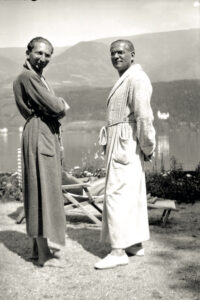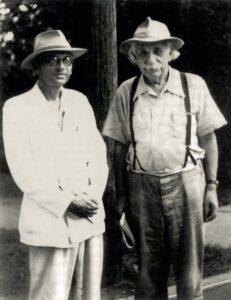The rhinoceros in the room
by Mika Provata-Carlone
“An exemplary piece of intellectual history, doing meticulous justice to the ideas and engrossing about the personalities involved.” New Statesman
In one of the most famous duels of elephantine minds, Bertrand Russell would challenge Ludwig Wittgenstein to concede that there was no rhinoceros in the Cambridge room that served as their legendary battleground (in a different version of the story, Russell claimed that the pachyderm to be located was a hippopotamus). The question, under ongoing debate since 1911, would prove to be a mammoth-sized conundrum, worthy of its own special and monumental place in the annals of eternity. For Wittgenstein (or David Hume before him), even empirical knowledge was based on the logical process of induction, i.e. on a sequential build-up of propositions deriving from the simplest law that we are willing to acknowledge as the foundation of our perception and our experience of reality. Thus there is no axiomatic, only logical necessity, and what we claim as bottom-line facts, are just “asserted propositions”: put in simple terms, we cannot know in a totalising and irrefutable manner. For Russell, on the other hand, knowability is an inherent condition of the natural world, and what we obtain through this experiential process of cognisance of (or ‘acquaintance’ with, as he termed it) a physical object or phenomenon is a given, not an assumption or an affirmation. Physis is there, solid and incontestable. Empirical or naturalistic epistemology, together with logical atomism, were for him incontrovertible absolutes.
So what about the rhinoceros? The story goes that Russell made a semblance of looking under the table in order to coax Wittgenstein to admit its non-existence, although we do not know for a fact if he also checked to see whether the rhinoceros might be perching on the mantelpiece, hanging from the ceiling light, or had taken refuge behind a curtain. Wittgenstein apparently held his ground, on the basis that one cannot prove a negative. It is a highly suggestive and revealing story of what one might call a particularly elusive ‘philosophical unicorn’, a zoological association that is warranted by confirmable historic materiality: in around 400BC, the Greek doctor Ctesias, then in the service of the Persian King Artaxerxes II, wrote in his book On India of a wild ass-like animal with a single horn that possessed magical and pharmaceutical properties. His monoceros, through the further elucidating contributions of Pliny the Elder,would become the basis of the natural history of the rhinocerotidae, and engender the more metaphysical legends of the unicorn.
The Vienna Circle [was] a formidably feisty, eminently irreverent, impalpably pluralistic and exponentially influential group that strove to shake the very foundations not only of science and thought, but of existence itself.”
In the case of both Russell and Wittgenstein, the most quest-worthy unicorn was philosophy itself, reality and illusion, language, meaning, the power and impotence of politics and society, the authority of the human intellect in determining the boundaries and boundlessness of experience and the cosmos. Both would be claimed as the cornerstones of the Vienna Circle, a formidably feisty, eminently irreverent, impalpably pluralistic and exponentially influential early 20th-century philosophical group that strove to shake the very foundations not only of science and thought, but of existence itself. Its members, staunch proponents of logical positivism (or logical empiricism), sought to stand against what they saw as dangerous obscurantist proclivities in their time, epistemological or socio-ideological trends that were falsifying both science and philosophy, and especially society. Tracing an adversarial genealogy from Plato, Aristotle, Hegel and Kant, all the way to the present foes they saw in Ernst Cassirer and the Marburg School, in Edmund Husserl and his phenomenology, and particularly in Martin Heidegger and his darkly eccentric syncretism of both phenomenology and existentialism, but also, rather polemically, in the Frankfurt School of Horkheimer and Adorno, the Vienna Circle argued instead for a neo-Enlightenment, explicitly anti-metaphysical process of reasoning and analysis. Their targets were both intellectual (what they saw as being pseudo-concepts of science or philosophy) and social, castigating political sophism, populism and demagogy, as well as discrimination and inequality of any kind.

Herbert Feigl and Moritz Schlick. Institut Wiener Kreis. The Vienna Circle: Exact Thinking in Demented Times, University of Vienna, 2015
The Vienna Circle was one of the many urgent, animated and inspired responses to the critical challenges of a particular moment in time. For both its ‘inner’ members (among whom were Otto Neurath, Hans Hahn, Rudolf Carnap, Herbert Feigl, Moritz Schlick, Philipp Frank, Richard von Mises, Karl Menger, Kurt Gödel, Friedrich Waismann, and Felix Kaufmann), and its patron saints or mentor figures such as Einstein, Wittgenstein, Russell, Gottlob Frege, Hans Reichenbach or Oskar Morgenstern, the years that followed WWI were years of radical dichotomy, of structural disintegration leading to either total re-dimensioning and redefinition or to total nothingness. The historical sense of an ending that affected practically all political, national, societal, academic or cultural institutions, and the tensions underlying the polarising claims that either a ratiocentric or a mystical perspective would provide the only way beyond what was universally recognised as a catalytic crisis, would engender a multitude of -isms or other ideological, philosophical and existential constructs or vital movements in a disparate yet universal effort to rebuild a failing world. The uniqueness of the Vienna Circle lies in the variability and evolutionary development of its rigidly logical doctrine(s), in the cross-pollinating, vital relationships it sought to establish with other parallel groups in Berlin, Warsaw, Prague, Cambridge or, later, across academic institutions in the US; in the vitality of its members, the extraordinary, fiercely dogmatic brilliance and often tragic humanity of their individual stories. Ultimately, in the sweeping repercussions of its ‘failure’: it can claim (or disclaim) as its descendants not only Anglo-American analytic philosophy, but also structuralism, semiotics, sociolinguistics, game and probability theory, AI, algorithms and big data analysis, machine learning or psychometrics, and even Lacanian psychoanalysis and the postmodernist theorising of Gilles Deleuze and Félix Guattari.
The unifying positions of the Vienna Circle were that it was necessary to fundamentally connect science and philosophy – with the latter serving the former in an ancillary, clarificatory role; that language, through a strictly rational, formalist interpretation and systematisation, was critical to distinguishing between true and false statements on the basis of pure logical meaningfulness, and on the principle of empirical knowability and verifiability (or confirmability); that metaphysics, both in the sense of theology or eschatology, and in the sense of anything that may be beyond or outside the strictly empirical, was a fallacy, a wrong turn on the path of logical analysis, deriving from the misleading polysemy and metaphoricity of natural language; moreover, for the neopositivists metaphysics, theology, ontology were congruent upon socioeconomic tensions and divides, they expressed power struggles rather than eschatological visions or revelations. They hence constituted pseudo-statements, factually unverifiable, and therefore, or so they claimed, devoid of meaning. Modernity needed new thinking processes, a new world outlook, radically different socioeconomic structures. Social dialectics were as significant as scientific theories, at least for those among the Vienna Circle members who also shared leftist sympathies, from loosely liberal to committedly Marxist (although a certain Ulyanov would become an unsavoury bugbear for all). As Otto Neurath would say, “after the lost war, there were more difficulties in the world, but [also] more chances that things could change.”
The Isotype was a titanic equalising force. It would become the tool of choice of politicians, public speakers and social messengers of any form, of museums, airports and train stations, highways and nursery schools.”

Kurt Gödel and Albert Einstein. Institut Wiener Kreis. The Vienna Circle: Exact Thinking in Demented Times, University of Vienna, 2015
Together with his wife Marie, the sister of Hans Hahn, Neurath would devise a revolutionary method of symbolic or pictographic language called the Isotype, which was essentially a universalising formula of systematic communication, a formalist system of instruction based on nugget-sized, conceptually parcelled information – a kind of essentialist statistics of merit-worthy knowledge. The Isotype was a titanic equalising force in providing modernity-appropriate education for the masses, and for popularising the tenets and outlook of the neopositivists; it was a superb instrument for mathematicians, or for social and pure scientists, the ultimate vehicle for technical and social progress, or even for the expansion of business and commerce. It would become the tool of choice of politicians, public speakers and social messengers of any form, of museums, airports and train stations, highways and nursery schools. It was, on the surface, almost ridiculously simple, yet this elementariness required a fiercely complex process of reduction to prime semantic constituents, and it expressed especially the Vienna Circle’s perhaps highest ambition: a universal master narrative through what they termed ‘unified science’. The Vienna Circle shifted the emphasis of philosophy (and arguably of science) from the pursuit of meaning and teleology, to the logical analysis and structural taxonomy of sense and non-sense (Sinlösigkeit). Their notion of Einheitswissenschaft, a grand sublimation of an Enlightenment vision of pangnosticism, of an encyclopaedic encapsulation of cognition, is fundamentally a project of epistemological oneness as well as of totalising wholeness.
This epistemic oneness and wholeness, the claim to a universal knowability, and the logical atomism that underlie their theories of science, language and society, are evoked in almost rhapsodic terms throughout the various Vienna Circle writings and anecdotal stories – there is an unmistakable aura of a holy grail, for all their iconoclastic proclamations. Blanche Schlick, Moritz Schlick’s wife, would say that on his first meeting with Wittgenstein “it was as if he were preparing to go on a holy pilgrimage”, and that he spoke of Wittgenstein “almost with awesome reverence”. There was something crusader-like about the Vienna Circle, which is equally breathtaking and problematic, both in terms of theoretical principles and analysis and, on several levels, of humanity. Their anxiety to cleanse thoughts, actions, societal structures of what could not be reasoned out shares much of the fervour of the Romanticist project, yet it also (and perhaps more so in retrospect) conjures up darker phantoms of particular types of totalitarianism. In many ways, the supreme lucidity of the Vienna Circle is also, and in a great many ways, the source of its obliterating blindness. It would be interesting to draw a parallel between the Vienna Circle and the Second Vienna School in music, with its similarly impressive gathering of inquisitive minds. In the latter, the figures of Arnold Schönberg, Alban Berg, Nikos Skalkottas, Anton Webern, also sought a pure and systematic model of musical composition, of musicality itself. Yet for them, modernity did not require either a breach with tradition or a renunciation of a transcendental dimension in art, in the science of sound, the creative potential of the human mind. For the latter, man was not the measure, but merely the measurer of all things, worldly or otherwise.

Cover mock-up by Otto Neurath for his intended ‘visual autobiography’. Isotype Institute, c. 1944. Isotype Revisited, The Otto and Marie Neurath Isotype Collection
The Vienna Circle would soon become defined as much by its monistic focus as by the vast divergence in perspectives, propositions, definitions of its scope and purpose. In that, it was an extraordinarily vigorous, living organism, and David Edmonds, in his latest book The Murder of Professor Schlick: The Rise and Fall of the Vienna Circle, pays superb tribute to the effervescence of the Vienna Circle project, to the individual dramas and character traits, to the many journeys, peregrinations or cyclical meanderings undertaken by its key members. Schlick and his assassination is an à propos, rather than a main event. It provides the cause célèbre around which Edmonds drafts an intrepid narrative on the evolution and multiple directions of a particular genus of scientific theories and philosophical schools in the 20th century, on Vienna and the historical circumstances and events of the interwar period, on the ongoing debate between science and religion, man and God. The history of the Vienna Circle, and the many stories embedded in its brief but stratospheric course, are intensely personal for Edmonds, both in terms of his own philosophical convictions and preoccupations, and because much of it is literally kith and kin: his great-grandfather was Walter Hollitscher, a friend of Elias Canetti and Paul Feyerabend, who would study under Schlick and become a prominent Marxist-Freudian theorist. He went to teach Logic and Theory of Knowledge after the war in the DDR, focusing on Freud, Marxism and physics, and was even arrested by the Stasi, only to reappear “under mysterious circumstances, in his home city of Vienna”, according to one of the stories. Back in Vienna, he would combine ardent political involvement with unyielding scholarship in philosophy and the social sciences, becoming an almost totemic figure of both brilliance and a certain ideological monolithism, according to Feyerabend.
Edmonds possesses a strong sense of audience, and he knows that a charismatic oratorical thrust makes for a riveting story. His account of the Vienna Circle is determinedly multifocal, as well as staunchly partisan.”

Neurath often signed his letters with a drawing of an elephant, an allusion to his bulky physique. University of Vienna/The Otto and Marie Neurath Isotype Collection
There are strong echoes of Hollitscher’s dialectical materialism and of his focus on sociohistorical analysis and problematisation also in Edmonds’ vital concern to retrieve silenced or repressed narratives. The Murder of Professor Schlick is part history, part redolent eulogy of logical positivism, or at least of the tenets at the core of its vision, and of particular, deeply critical human experiences. Edmonds possesses a strong sense of audience, and he knows that a charismatic oratorical thrust makes for a riveting story. His account of the Vienna Circle is determinedly multifocal, as well as staunchly partisan or, more accurately, direct in the positioning of its angles and prisms. This gives his story a strong grounding, but it can also feel reductive or, on occasion, tenuously polemical, especially in its microfocus, which could have benefitted from a more inclusive context of other theoretical or philosophical ventures. There are also a few argumentative glissades rather than strict logical steps, a certain number of conceptual fusions that disregard proper categorical distinctions, and a tendency for hysteron proteron in the tracing of conceptual genealogy and causation. Also a hard-to-miss bias against critics or detractors (or mere non-initiates). Yet the overall project remains unfailingly enthralling, a feast of philosophical considerations, an absolutely engrossing panorama of many questions and many lives. Edmonds is at his best on the human and biographical level, in the dissection of personal dynamics, and of sociohistorical forces. He offers a fine analysis of the pitfalls and toxic powers of groupthink mentality, of the inherent contradictions in the aims and tenets of the Vienna Circle, the tensions between undeniably ferocious personalities. He builds a bracing crescendo in the narrative as he unfolds their stories, as he evokes both powerfully and harrowingly the gradual rise of Nazism, antisemitism, everyday relentless brutality, the ambiguities and tragedies behind secular or assimilationist Judaism, or the irrefutably mind-bending thinking processes and arguments involved.
The wealth of sources he rallies to his cause is truly formidable, even if the narrative method can seem cyclical at times – the writing style has an impromptu or reportage quality that would have been perfectly pitched for a dramatised documentary on his subject. Yet perhaps this is precisely the point: to resurrect and revitalise thoughts, lives and voices with reverberating urgency and immediacy. Edmonds emerges as an energised and energising amanuensis for his chosen characters, for their instincts and drives, their traumas and triumphs. He seeks to transcribe their every stir of brilliance or tint of sadness, the damning sense of injustice and the uncompromising vision that defined their work and lives, even their Jesuit fixations or Jabberwocky reasonings. Their unique significance is that they distilled, for Edmonds, what is most vital in any form of thought, communication or discussion: the need to focus on what we mean with anything we say, and on how we know anything we may wish to claim. As Wittgenstein says in the Tractatus, “Everything that can be thought at all can be thought clearly. Everything that can be said can be said clearly.” This pursuit of clarity, which came at times even at the expense of many other vital organs of the social and individual human constitution, was for them more than an intellectual preoccupation. As Edmonds argues, it was a matter of sheer existence, a lifeline out of darkness, chaos, even nothingness – the latter being a concept that was particularly thorny in their minds and vision.
 David Edmonds is the co-author, with John Eidinow, of Wittgenstein’s Poker, Rousseau’s Dog and Bobby Fischer Goes to War (Faber), co-author with Bertie Fraser of the children’s book Undercover Robot (Walker Books) and the author of Would You Kill the Fat Man? (Princeton University Press). Co-founder with Nigel Warburton of the Philosophy Bites podcast series, he is a distinguished research fellow at the Oxford Uehiro Centre for Practical Ethics, an award-winning presenter and producer and the host of the BBC’s The Big Idea. The Murder of Professor Schlick is published in hardback and eBook by Princeton University Press.
David Edmonds is the co-author, with John Eidinow, of Wittgenstein’s Poker, Rousseau’s Dog and Bobby Fischer Goes to War (Faber), co-author with Bertie Fraser of the children’s book Undercover Robot (Walker Books) and the author of Would You Kill the Fat Man? (Princeton University Press). Co-founder with Nigel Warburton of the Philosophy Bites podcast series, he is a distinguished research fellow at the Oxford Uehiro Centre for Practical Ethics, an award-winning presenter and producer and the host of the BBC’s The Big Idea. The Murder of Professor Schlick is published in hardback and eBook by Princeton University Press.
Read more
davidedmonds.info
@DavidEdmonds100
@PrincetonUPress
Mika Provata-Carlone is an independent scholar, translator, editor and illustrator, and a contributing editor to Bookanista. She has a doctorate from Princeton University and lives and works in London.
bookanista.com/author/mika/

